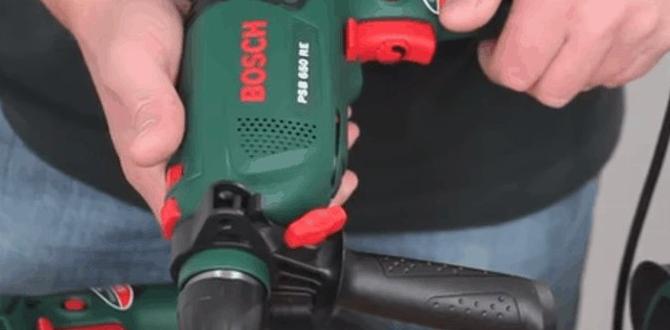Yes, using a nailer for furniture drawers is not just a good idea, it’s practically essential for a quick, strong, and professional finish. It secures corners, attaches drawer fronts, and adds stability far better than manual hammering, saving you time and effort for a perfect build.
Hey there, fellow DIYers! Jack Shaffer here, your go-to guy for all things nailers and woodworking. Ever find yourself struggling with those wobbly, hard-to-assemble furniture drawers? You know, the ones where every corner feels like a wrestling match, and you end up with more splinters than a pine forest? Well, you’re not alone. Building drawers can be a bit finicky, and getting those joints just right can feel like rocket science sometimes. But what if I told you there’s a tool that can make this process significantly easier, faster, and yield much stronger results? We’re talking about using a nailer for furniture drawers. It’s a game-changer, and I’m about to show you exactly why and how to do it like a pro. Get ready to upgrade your drawer-building game!
Table of Contents
Why a Nailer is Your New Best Friend for Furniture Drawers
Let’s be honest, traditionally, building drawers involves a lot of precise cutting, wood glue, and then painstakingly driving small nails or screws by hand. This can be time-consuming, prone to error (ever hit your thumb instead of the nail?), and the resulting joints might not be as sturdy as you’d like. This is where a nail gun, specifically the right nailer, steps in to save the day.
Think about it: drawers undergo regular stress. They slide in and out, hold varying weights, and their joints need to be robust. A nailer delivers fasteners quickly and accurately, creating strong mechanical bonds that complement wood glue perfectly. It streamlines the entire assembly process, making it more enjoyable and yielding professional-looking results, even for beginners.
The Strength Factor: Beyond Just Holding Things Together
When you’re building furniture, especially something that gets a lot of use like a drawer, durability is key. The joints are where the magic (or the failure) happens. Using a nailer drives fasteners deep into the wood, creating a secure connection. When combined with good quality wood glue, you get a joint that’s significantly stronger than one assembled with just glue or screws driven by hand.
This robust connection is especially important for:
Drawer Box Corners: These take the brunt of the force when you pull and push drawers. Nails ensure these corners stay tight and don’t rack or twist.
Attaching Drawer Fronts: Getting a drawer front perfectly aligned and secured without marring the surface can be tricky. A nailer allows for quick, precise fastening.
Reinforcing Undermount Slides: Many modern drawer slides require secure attachment to the drawer box. A nailer makes this a breeze.
Securing Drawer Bottoms: Instead of fiddly screws or trying to nail through thin plywood by hand, a nailer can quickly secure the bottom panel to the box.
Speed and Efficiency: Get More Done, Faster!
For any DIYer or hobbyist, time is precious. If you want to build more furniture, complete more projects, or simply get that drawer assembly done this weekend, a nailer is a massive time-saver. What might take 15-20 minutes of careful hammering or screwing can often be accomplished in a fraction of that time with a nail gun. This efficiency boost means you can focus on other aspects of your project, fine-tuning details, or even starting the next build!
Precision and Professional Finish: Say Goodbye to Wobbly Drawers
Ever built a drawer that felt a little… off? Slightly crooked, corners not perfectly square? This is often due to inconsistent fastening. A nailer, when used correctly, drives nails straight and consistently. This leads to tighter joints, perfectly square boxes, and a much more professional appearance. No more visible glue squeeze-out on one side and a large gap on the other.
Choosing the Right Nailer for Furniture Drawers: It Matters!
Now, not all nailers are created equal, and for furniture drawers, a specific type often shines. While a framing nailer is for big jobs, and a roofing nailer is for the roof, we need something a bit more refined.
The Staple Choice: The Brad Nailer
When it comes to furniture drawers, the undisputed champion is the brad nailer.
What is a Brad Nailer? A brad nailer drives thin, slender nails (brads) ranging from 16-gauge to 18-gauge. These nails are minimally invasive, meaning they leave a very small hole that’s easy to fill and hide, ensuring a clean look.
Why it’s Perfect for Drawers:
Small Gauge Nails: The thinness of the nails won’t split fine woodworking joints or leave large, unsightly holes.
Excellent Holding Power: Despite their size, brads provide satisfying holding power, especially when used in conjunction with wood glue.
Versatility: They’re excellent for attaching drawer fronts, assembling drawer boxes, attaching trim, and even delicate molding.
Other Nailers to Consider (and Why They Might Be Less Ideal)
Finish Nailer (15-gauge or 14-gauge): These drive slightly thicker nails than brad nailers. While they offer more holding power, the larger nail head and hole might be more noticeable on smaller drawer components. They are great for thicker trim or structural parts but can be overkill for delicate drawer assembly.
Pin Nailer (23-gauge): These drive ultra-fine headless pins. They are fantastic for holding delicate trim or decorative elements in place while glue dries, but they offer very little structural holding power. They are not sufficient for the main assembly of a drawer box itself.
Framing Nailer: Absolutely not for drawers! These are for heavy construction and drive much larger, thicker nails designed for structural framing – way too big and destructive for furniture.
Staple Gun (Hammer Tacker or Pneumatic Stapler): While some small furniture pieces might use staples, they generally don’t offer the same clean finish or structural integrity for drawer joinery as brad nails, especially on the visible parts.
Our recommendation for drawers? Stick with a 16-gauge or 18-gauge brad nailer.
Essential Tools and Materials for Your Drawer-Building Project
Beyond the nailer, here’s what you’ll need to make your drawer-building project a success:
Your Chosen Nailer: A 16-gauge or 18-gauge brad nailer is ideal.
Air Compressor (if using a pneumatic nailer): Ensure it’s rated for your nailer’s PSI requirements.
Air Hose and Fittings: For connecting the compressor to the nailer.
Wood Glue: A quality wood glue is your best friend for reinforcing nail joints.
Wood for Your Drawer: Choose appropriate lumber for the drawer box (e.g., pine, poplar) and drawer front.
Measuring Tape and Pencil: For accurate measurements and marking.
Saw: To cut your wood to size (circular saw, miter saw, or even a handsaw).
Clamps: Essential for holding pieces together while glue dries and for a tight fit before nailing.
Safety Glasses: Non-negotiable! Always protect your eyes.
Safety Gloves (Optional): For a better grip and protection.
Nails: Ensure you have the correct gauge and length of brads for your nailer and the thickness of your wood. A good rule of thumb for drawer boxes is 1 ¼” to 1 ½” brads for ½” to ¾” thick material.
Wood Filler or Putty: To fill nail holes for a smooth finish.
Sander and Sandpaper: For smoothing edges and preparing for finishing.
Step-by-Step Guide: Using Your Nailer for Furniture Drawers
Let’s break down the process. We’ll cover assembling the drawer box and then attaching the drawer front.
Part 1: Assembling the Drawer Box
This is where the nailer really speeds things up. We’re assuming you’ve already cut your drawer sides, front, and back pieces to size. You’ve also cut a dado or groove for the drawer bottom.
Step 1: Prepare Your Workspace and Tools
Ensure you have all your tools and materials ready. Set up your nailer, connect it to your air source (if pneumatic), and load it with the appropriate brads. Make sure your wood glue is accessible.
Step 2: Apply Wood Glue
Generously apply a thin, even layer of wood glue to the edges where the drawer sides will meet the drawer front and back. For example, apply glue to the ends of the drawer front and back pieces that will connect to the side panels.
Step 3: Position and Clamp
Carefully position one side panel against the glued edge of the drawer front. Ensure the edges are perfectly flush. Use clamps to hold the pieces securely in place. This is crucial for a strong, square joint. Repeat for the other side of the drawer front and then for the back panel. You should have an open-ended box shape.
Step 4: Nail the Corners
Now, grab your nailer.
Safety First: Put on your safety glasses!
Nail Placement: Position the nailer so the nose is against the outside face of the drawer side panel, and the nail will drive into the edge of the drawer front (or back). Aim to place nails about ½” to ¾” from each corner and then spaced about 4-6 inches apart along the joint.
Firing: Gently press the trigger. The nailer will sink the brad into the wood. You might need to adjust the depth setting on your nailer to ensure the nail is fully countersunk without blowing through the opposite side of the wood.
Repeat: Continue nailing along the joint, making sure your pieces remain perfectly aligned.
The Other Side: Rotate your workpiece and repeat the nailing process for the other side of the drawer box, connecting the side panels to the back piece.
Step 5: Install the Drawer Bottom
If you’ve cut a groove (dado) for the drawer bottom, slide the bottom panel into place. Now, you’ll use your nailer to secure the bottom to the drawer sides, front, and back.
Glue (Optional but Recommended): Apply a bead of glue along the edges of the drawer bottom where it meets the box.
Nail: Fire your nailer through the sides, front, and back into the edge of the drawer bottom. Space nails every 4-6 inches. This prevents the bottom from sagging. Be careful not to overdrive the nails and create a hole in the visible surface of the bottom.
Step 6: Check for Squareness and Clean Up
Once all your nails are in, check that your drawer box is perfectly square using a framing square. If there are any slight gaps or misalignments, you can often adjust them before the glue completely cures. Wipe away any excess glue with a damp cloth.
Part 2: Attaching the Drawer Front
This is where a nailer really makes a difference in achieving a professional, seamless look.
Step 1: Position the Drawer Box on the Drawer Front
Lay your drawer front flat on a protected surface. Place the assembled drawer box onto the back of the drawer front. Use a framing square and measuring tape to position the box perfectly centered. You want a consistent reveal (the gap between the drawer box and the cabinet opening) on all sides. It’s helpful to mark reference lines on the back of the drawer front from your cabinet measurements.
Step 2: Secure with Clamps
Once positioned correctly, clamp the drawer box to the drawer front. Use several clamps to ensure the pieces don’t shift. This is critical.
Step 3: Nail from the Inside
This is the “genius” part that hides your fasteners.
Access: You’ll be firing nails from the inside of the drawer box, through the drawer front and into the edge of the drawer front panel.
Angle is Key: Hold your nailer at a slight angle. You want to drive the brads from the inside face of the drawer side/bottom into the back of the drawer front.
Placement: Place nails about ½” to ¾” from the edge of the drawer front, spaced every 4-6 inches. Work your way around all four sides of the drawer box. Be mindful of where your nails will go so they don’t come out the visible face of the drawer front. This is where practicing on scrap wood is invaluable!
Depth Setting: Again, set your depth so the nails are fully countersunk.
Step 4: Reinforce (Optional but Recommended)
For extra strength, you can also apply a bead of glue along the edges of the drawer box where it meets the drawer front before nailing.
Step 5: Fill and Finish
Once the glue is dry and you’re happy with the result, use wood filler or putty to fill any nail holes. Sand smooth and apply your desired finish (paint, stain, or clear coat). The small holes left by an 18-gauge brad nailer are remarkably easy to conceal.
Pro Tips for Using Your Nailer on Drawers
Practice on Scrap: Before you fire into your actual project, set up a few pieces of scrap wood of the same thickness and practice firing your nailer. Get a feel for the trigger, the depth setting, and how to get consistent results.
Set the Depth Correctly: Too deep, and you blow through the wood or create a large divot. Too shallow, and the nail head sticks out. Aim for the nail head to be just below the surface, ready for filling.
Nail Angles: When attaching a drawer front from the inside, experiment with the angle. A slight angle (10-15 degrees) is often best to get good penetration into the drawer front without compromising the exterior finish.
Air Pressure is Key: Ensure your compressor is set to the correct PSI for your nailer. Too much air can damage the wood or overdrive nails. Check your nailer’s manual for recommendations. Understanding air pressure is crucial for tool longevity and performance.
Keep It Clean: Regularly clean your nailer according to the manufacturer’s instructions. This ensures it operates smoothly and prevents jams.
Consider a Cordless Option: If you do a lot of DIY, a cordless battery-powered nailer can be a fantastic investment. They offer freedom from air hoses and compressors, though they can be pricier upfront.
Match Nail Size to Wood Thickness:
For thin drawer bottoms or delicate drawer fronts, use 18-gauge
For assembling the main box (sides, front, back), 16-gauge is often preferred.
Ensure your nailer can accommodate these sizes.
Common Drawer Drawer Nailer Problems & Solutions
Even with the best tools, sometimes things don’t go exactly as planned. Here are a few common issues and how to fix them:
| Problem | Cause | Solution |
| :————————— | :———————————————————————- | :————————————————————————————————————————————————————————— |
| Nail Jamming | Too many nails fed at once, obstruction, or bent nail. | Disconnect air (if pneumatic). Carefully remove jammed nail using pliers or the tool’s jam clearing mechanism. Ensure you’re using the correct nail size and that they are straight. |
| Nail Not Firing | Low air pressure, safety trigger not depressed, or internal issue. | Check air hose connection and compressor pressure. Ensure safety contact tip is pressed firmly against the wood. If pneumatic, check for leaks. If electric/battery, check charge/power. |
| Nail Overdriving/Blowing Through | Nailer depth set too high, or wood is too thin/soft. | Adjust the depth setting on your nailer (usually a dial near the nose). If still an issue, consider longer nails or a different nail gauge if appropriate for the wood. |
| Nail Underdriving | Nailer depth set too low, or low air pressure. | Adjust depth setting higher. For pneumatic, check and increase air pressure if necessary (within tool limits). Ensure the nose is pressed firmly against the surface. |
| Splitting Wood | Nailing too close to the edge, using too large a nail, or hard wood. | Nail further from the edge. Try a smaller gauge nail (e.g., switch from 16g to 18g). Pre-drilling a small pilot hole can help in very hard woods or near edges. |
| Nails Bending | Hitting a knot, incorrect angle, or nail is slightly bent. | Try repositioning the nail slightly. Ensure you’re firing at a perpendicular or slightly angled (but consistent) direction. Use straight nails. |
When to Use Glue In Addition to Nailing
While your nailer is fantastic, it’s important to remember that it’s often a partner to wood glue, not a replacement. For furniture drawers, I almost always recommend using both.
Why Glue Matters: Wood glue creates an incredibly strong molecular bond between wood fibers. When your nailer holds everything in place while the glue dries, you get a joint that’s significantly stronger than fasteners alone.
When to Definitely Use Glue:
For the main drawer box assembly (connecting sides to front and back).
When attaching the drawer front.
When securing the drawer bottom.
When Glue Might Be Less Critical (but still good):
Attaching tiny decorative trim (though a pin nailer might be better here anyway).
By




